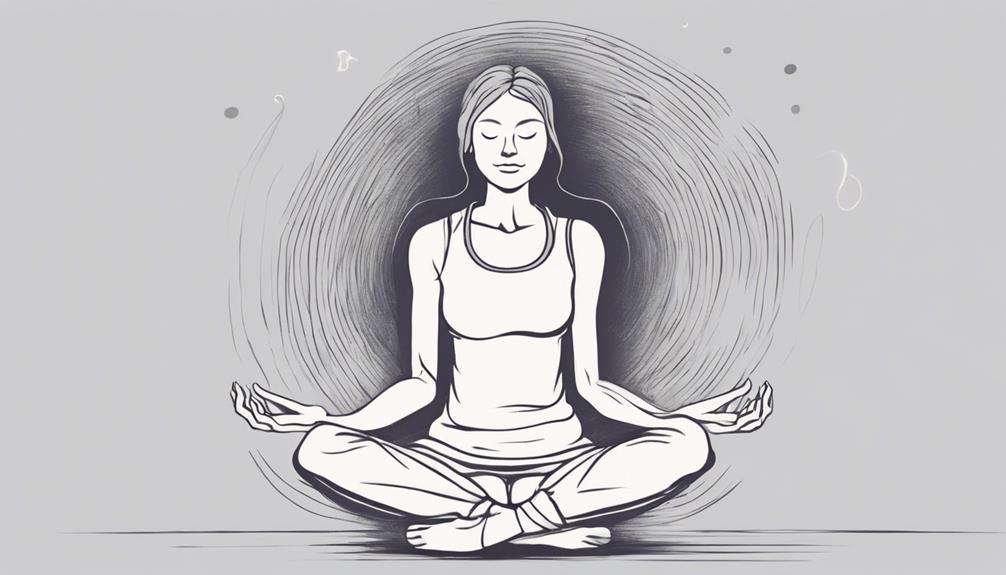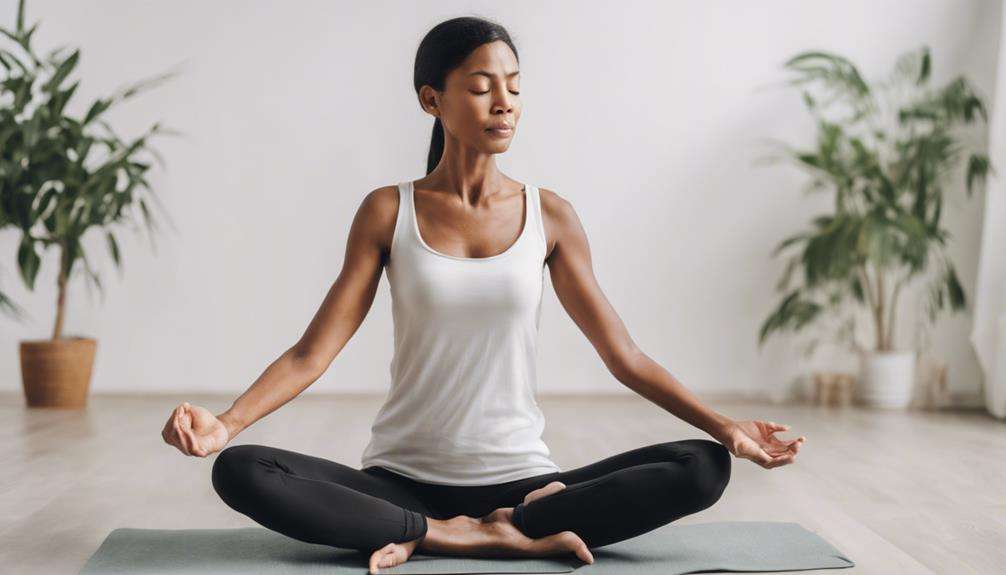When faced with discomfort, consider exploring the gentle yet effective techniques outlined in the article on mindful practices for pain relief through movement.
By incorporating mindfulness into your daily routine, you may unlock a pathway to managing pain that goes beyond conventional methods. These practices offer a holistic approach that could potentially transform how you perceive and respond to pain, providing a new perspective on pain management that you might find intriguing.
Key Takeaways
- Mindful breathing and gentle stretching alleviate pain and reduce stress.
- Mindful movement like walking and body scan meditation enhance pain management.
- Mindful yoga poses and dance therapy offer comfort and improve well-being.
- Holistic dance therapy integrates movement, emotional release, and improves quality of life.
Mindful Breathing Techniques
To begin your journey towards pain relief through movement, start by exploring the transformative benefits of mindful breathing techniques. Mindfulness involves focusing on the present moment, which can be particularly helpful in managing pain, stress, and emotional well-being. By practicing mindful breathing, you can direct your attention to the sensations of your breath entering and leaving your body. This focused awareness helps in calming the mind, reducing stress levels, and promoting relaxation.
Research has shown that incorporating mindful breathing into your daily routine can have a positive impact on chronic pain conditions. By engaging in mindful breathing exercises, you can activate the body's relaxation response, leading to a decrease in heart rate and blood pressure. This not only helps in managing physical pain but also supports emotional regulation and mental clarity. The practice of mindful breathing can be a powerful tool in enhancing your overall well-being and improving your quality of life.
Gentle Stretching for Pain Relief
Engage in gentle stretching exercises to alleviate muscle tension and enhance flexibility, supporting pain relief and overall physical well-being. Mindful stretching not only targets specific areas of discomfort but also helps improve your mindfulness practices. By incorporating gentle stretching routines into your daily regimen, you can effectively reduce muscle tension, increase blood circulation to promote healing, and release endorphins for natural pain relief.
Regularly practicing gentle stretches can also aid in improving your posture, reducing the risk of injury, and gradually alleviating chronic pain. Mindful stretching activities like yoga or tai chi offer a dual benefit by enhancing your mindfulness while addressing areas of pain and tension in the body. These practices not only increase flexibility but also help in stress reduction and overall well-being.
Mindful Walking for Relaxation

Begin your journey to relaxation and mindfulness through mindful walking, a practice that centers on focusing on the sensations of each step you take.
Mindful walking involves tuning into the movement of your muscles as you walk, and the sensations that arise from the connection with the ground beneath your feet.
Research has shown that integrating mindful walking into your routine can significantly reduce stress levels, elevate mood, and enhance overall well-being.
When practiced outdoors in nature, mindful walking deepens these benefits by fostering a stronger connection with the environment, promoting relaxation.
By incorporating mindful walking into your daily life, you can easily infuse mindfulness into your activities.
By paying attention to the present moment, each step, and each breath during mindful walking, you can cultivate a profound sense of presence and calmness.
This heightened awareness contributes not only to stress reduction but also to pain relief, making mindful walking a valuable practice for your overall well-being.
Body Scan Meditation for Pain Management
Embark on a journey of mindfulness and pain relief through the practice of body scan meditation, a technique that focuses on systematically observing different parts of your body. By incorporating body scan meditation into your routine, chronic pain patients can effectively manage their pain and improve their quality of life.
Here are some key benefits of body scan meditation:
- Enhanced Body Awareness: Body scan meditation helps you become more attuned to your body's signals, allowing you to identify areas of tension and discomfort more easily.
- Reduced Muscle Tension: Through the practice of body scan meditation, you can release pent-up muscle tension, promoting relaxation and alleviating physical strain.
- Improved Pain Management: Research suggests that regular body scan meditation can decrease pain perception, offering relief to those struggling with chronic pain conditions.
Mindful Yoga Poses for Comfort

Are you ready to explore gentle yoga poses that can bring you comfort and relief?
These poses focus on relaxation and breathing techniques to help you find inner peace and calm.
Gentle Poses for Relaxation
When seeking comfort and relaxation through mindful yoga practices, gentle poses like Child's Pose, Cat-Cow, and Legs Up the Wall offer soothing relief and promote a sense of calmness and ease in the body.
These gentle yoga poses focus on deep breathing, reducing tension, and enhancing relaxation responses. By incorporating mindful movement into your routine, you can increase body awareness, decrease muscle stiffness, and find relief from physical discomfort.
Practicing these poses regularly can help alleviate pain, reduce stress, and improve your overall well-being. Remember to breathe deeply and listen to your body's needs as you engage in these comforting poses for relaxation.
- Deep breathing techniques
- Reduction of tension in the body
- Enhanced relaxation responses
Breathing Techniques for Focus
As you explore mindful yoga practices for comfort, incorporating specific breathing techniques can significantly enhance your focus and relaxation during movement. Mindful breathing in yoga poses fosters a deep mind-body connection, allowing you to center your awareness on the present moment.
By engaging in deep breathing exercises while holding yoga poses, you promote relaxation and reduce stress, ultimately leading to enhanced comfort. Proper breathing techniques support the flow of oxygen to your muscles, aiding in flexibility and ease of movement.
Through mindful breathing, you cultivate a heightened awareness of your body sensations, fostering a sense of calmness and tranquility during physical activity. Embrace these breathing practices to optimize your focus and overall well-being during mindful yoga sessions.
Tai Chi for Mindful Movement
Incorporate the ancient art of Tai Chi into your routine for mindful movement that can aid in pain relief and enhance overall well-being. Tai Chi, with its gentle movements and focus on deep breathing, is a powerful tool for chronic pain management. Here are some key benefits of practicing Tai Chi:
- Enhances body awareness: Tai Chi movements encourage you to be fully present in the moment, fostering a deeper connection between your mind and body.
- Promotes relaxation and mindfulness: The meditative aspect of Tai Chi helps in reducing stress levels and promoting a sense of calmness.
- Improves quality of life: Regular practice of Tai Chi has been shown to decrease pain intensity and improve overall quality of life for individuals dealing with chronic pain conditions.
Accessible to individuals of all ages and fitness levels, Tai Chi provides a low-impact way to incorporate mindful movement into your daily routine, offering a holistic approach to pain relief and well-being.
Dance Therapy for Pain Alleviation

With dance therapy, you can explore movement patterns, express emotions, and develop coping strategies for managing pain. Trained therapists guide sessions to help you connect mind and body, release tension, and increase body awareness.
Engaging in dance therapy can provide a creative outlet for self-expression, promote relaxation, and empower you to take control of your pain experience.
Movement and Pain Relief
Utilize the power of dance therapy to effectively manage pain by engaging in mindful movement practices that promote relaxation, mobility, and emotional well-being. Dance therapy, a form of movement therapy, offers various benefits for pain management and overall well-being. Through this practice, you can enhance your body awareness, reduce stress, and express emotions, contributing to a decrease in pain intensity associated with chronic pain.
Incorporating breath work, mindfulness, and gentle movements in dance therapy sessions can help alleviate muscle tension, improve flexibility, and enhance your quality of life. By participating in dance therapy, you can explore a holistic approach to pain relief that not only targets physical discomfort but also supports your emotional and mental health.
- Enhance body awareness
- Reduce stress
- Express emotions
Dance as Therapy
Dance therapy offers a dynamic and expressive approach to pain alleviation, integrating movement and emotional release for enhanced well-being and reduced discomfort. Engaging in dance therapy allows individuals to tap into their emotions, release tension, and cultivate body awareness.
Research indicates that this form of movement therapy can decrease pain perception, enhance mood, and improve overall quality of life. Dance therapy sessions typically involve guided movements, music, and creative expression, providing a holistic approach to managing chronic pain and enhancing mental health.
Frequently Asked Questions
What Type of Mindfulness Activity Is Most Beneficial in Pain Reduction?
To reduce pain effectively, focus on activities like yoga poses, walking meditation, and tai chi movements. Incorporate breath awareness, body scans, and stretching techniques. Try dance therapy, mindful running, Pilates exercises, and guided imagery for holistic pain relief through mindful practices.
What Are Movement Based Mindfulness Activities?
Embrace movement-based mindfulness activities like yoga therapy and tai chi. Connect breath with motion, heightening body awareness. Engage in mindful stretching and walking meditation for pain relief. Explore the Feldenkrais method or qigong practice for holistic well-being.
How to Do Mindfulness for Pain?
To practice mindfulness for pain relief, start by focusing on the present moment. Engage in mindful breathing, body scans, and guided meditation. Use techniques like progressive relaxation to tune into your body, reduce pain perception, and enhance well-being.
Can Mindfulness Exercises Help Someone Reduce Symptoms of Physical Pain?
You can find relief from physical pain through mindfulness exercises. Techniques like meditation, deep breathing, and body scans enhance your mind-body connection, reducing pain symptoms. Engage in yoga, Tai Chi, or stretching for holistic pain management.
Conclusion
In conclusion, incorporating mindful practices into your daily routine can greatly aid in managing chronic pain. By focusing on breathing techniques, gentle stretching, walking mindfully, and engaging in body scan meditations, you can alleviate pain and reduce the need for medication.
Remember, Rome wasn't built in a day, so be patient with yourself as you explore these practices and discover what works best for you. Stay mindful, stay resilient, and keep moving forward on your journey to pain relief.






